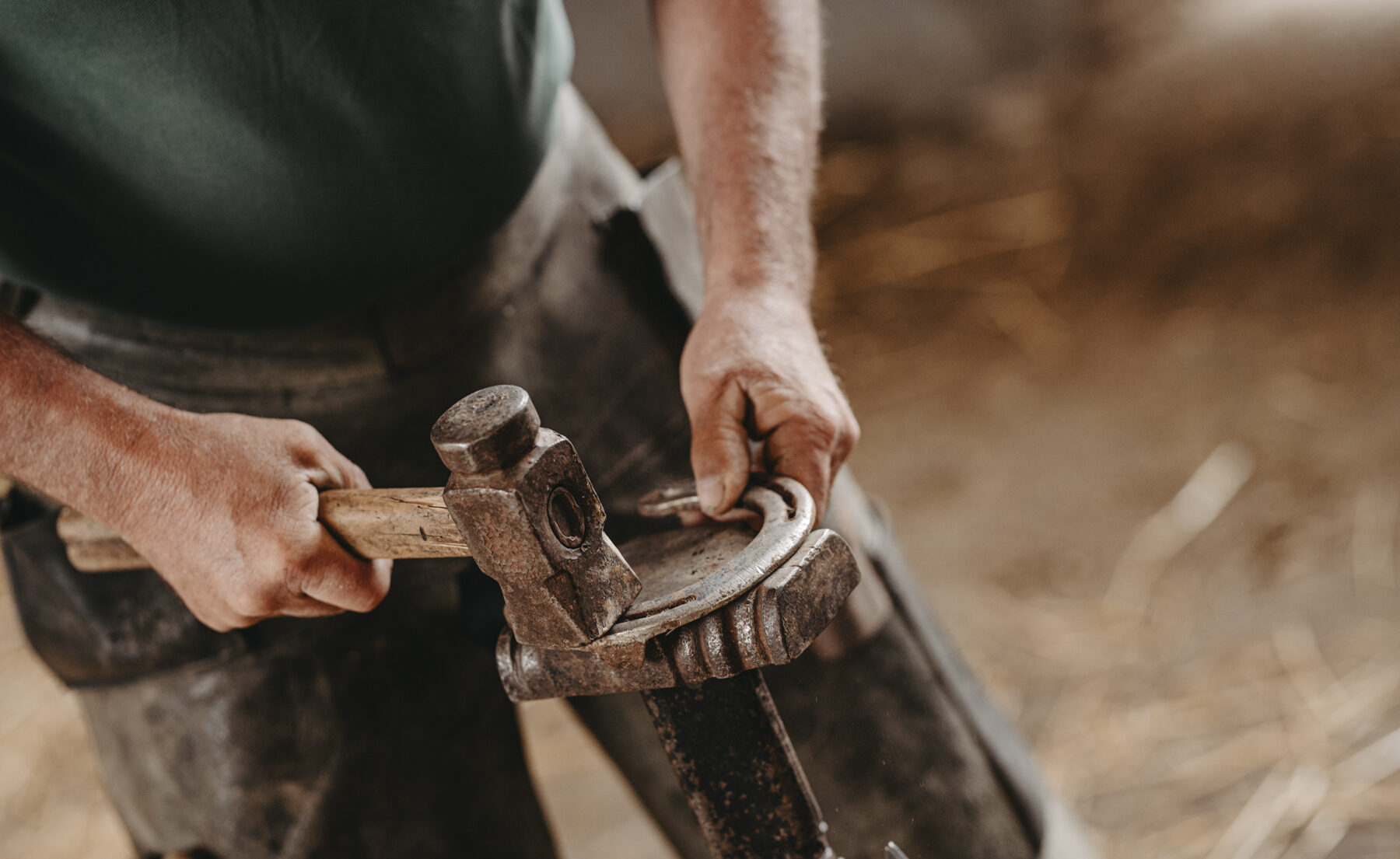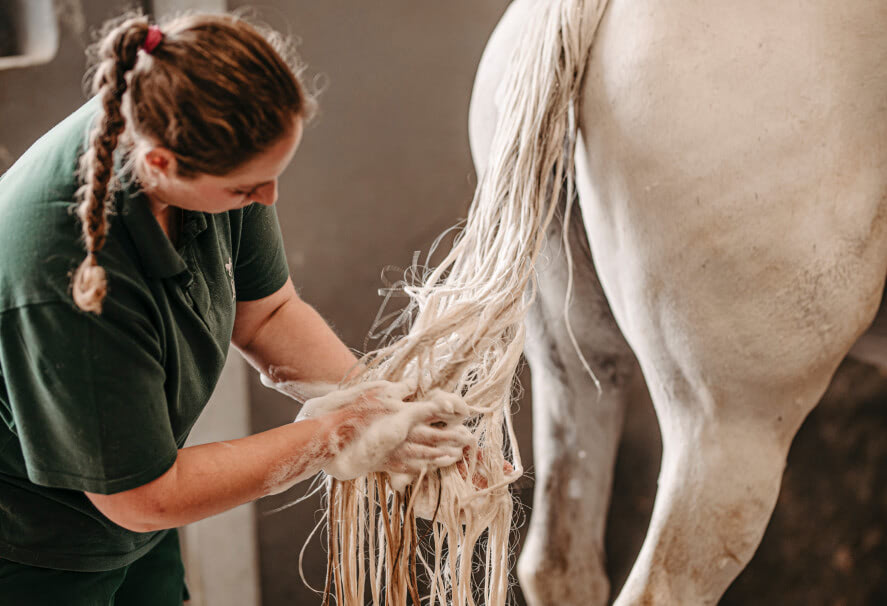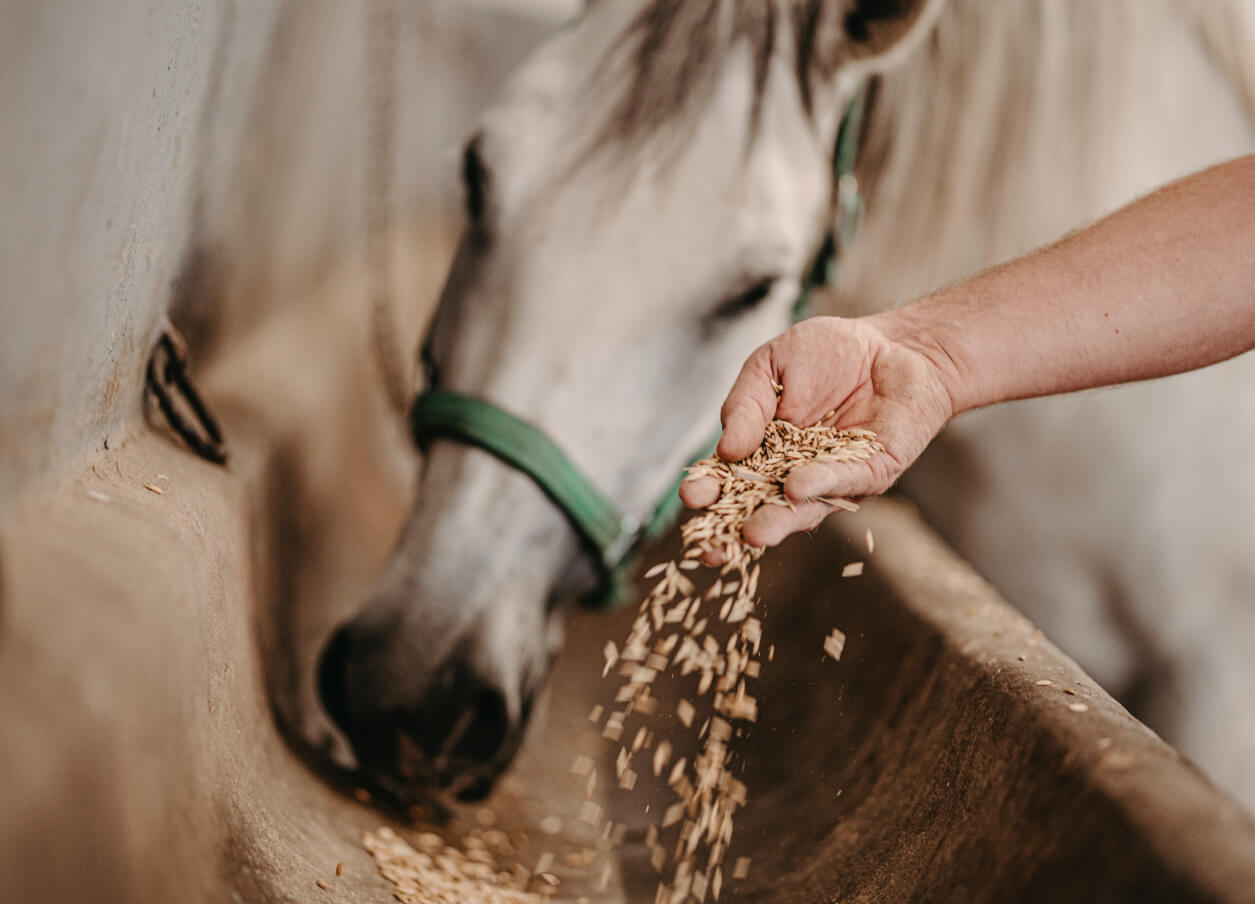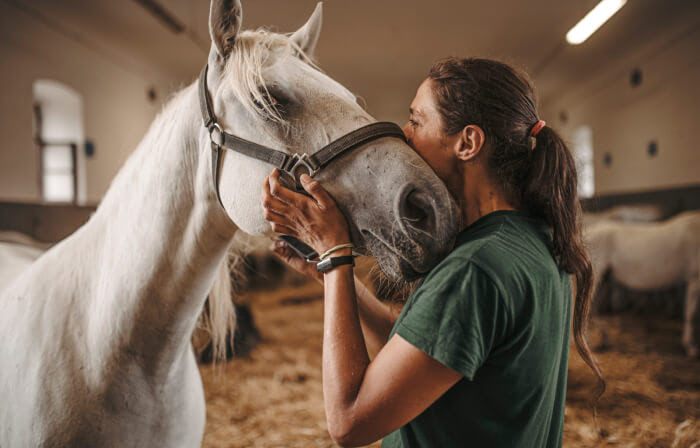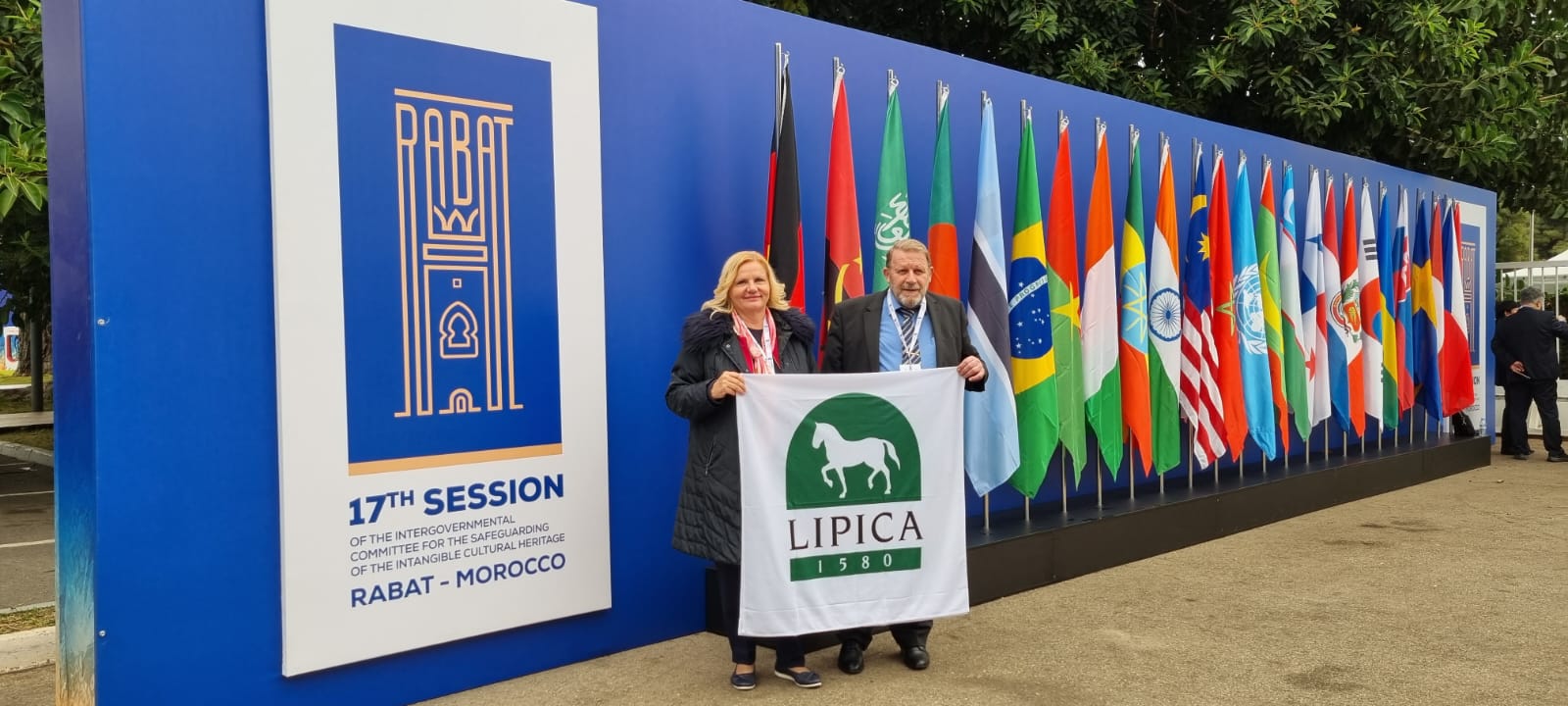At the Lipica Stud Farm, we are delighted with the birth of the first foal of this year. On Women’s Day, March 8, a little playful Neapolitano Dubovina XXXV came into the world. By June, another 27 foals will join the Lipizzan herd.
Little Neapolitano Dubovina XXXV, was born early in the morning, before sunrise. He quickly stood on his feet and began to drink his mother’s milk, now eagerly observing the world around him.
His well-being is constantly looked after by his mother 635 Dubovina XXXV. The father of the little colt is 562 Neapolitano Betalka XXVI, who will soon be admired by visitors to the Lipica Stud Farm in performances.
This year marks the third consecutive year that the first foal was born right on March 8, International Women’s Day.
The firstborn foal of this year’s generation, Neapolitano Dubovina, was born in the safe environment of the stables at Borjača, where all Lipizzan foals are born. Together with his mother, he will spend the first week in the birthing boxes, and then join the herd, which will be increasingly filled with playful foals and their caring mothers every day.
By the beginning of June, we expect a total of 28 foals in Lipica. Visitors will be able to first meet them in the courtyard of the stables at Borjača, and in the warm days of May also on the vast green pastures of Lipica.
The birth of foals is one of the most beautiful experiences for the employees at the Lipica Stud Farm, especially those who take care of them, and a motivation for further work.
The director of the Lipica Stud Farm, Mag. Tatjana Vošinek Pucer, accompanied the birth of the first foal of this year with the wish that, lively and playful – together with the Lipizzan foals – the awareness of the importance of the Lipica Stud Farm and our noble horses will grow.
Enrollment of Lipizzan breeding on the UNESCO Representative List of the Intangible Cultural Heritage.
The tradition of Lipizzan breeding was on the first of December 2022, enrolled on the UNESCO representative list of the intangible cultural heritage of humanity.
The tradition of Lipizzan breeding in all eight participating countries has been enrolled on the Representative List.
The partner countries are: Austria, Bosnia and Herzegovina, Croatia, Italy, Hungary, Romania, Slovakia, and Slovenia. Lipizzan breeding still relies on principles dating back to the second half of the 18th century. Knowledge of breed development, expertise and practical experience are prerequisites for intentional breeding, daily practices and routines, skills and abilities of horse trainers, riders, carriage drivers, and breeding farriers, as well as training horses under saddle and in harness.
An important aspect related to these activities is the relationship between humans and horses, based on trust and partnership, in which the horse is treated as an equal partner or even a family member.
Lipizzan breeding still relies on principles dating back to the second half of the 18th century. Knowledge of breed development, expertise and practical experience are prerequisites for intentional breeding, daily practices and routines, skills and abilities of horse trainers, riders, carriage drivers, and breeding farriers, as well as training horses under saddle and in harness.
An important aspect related to these activities is the relationship between humans and horses, based on trust and partnership, in which the horse is treated as an equal partner or even a family member.
The breeding of Lipizzan horses involves knowledge and skills of horsemen, riders, carriage drivers, trainers, breeders, veterinarians, and others who actively participate in breeding.
Employees in state studs are the central carriers of the element. There are specific roles of employees in studs who are responsible for breeding, rearing, training, and education. They keep records, follow the purposes and methods of breeding, as well as traditional regulations and routines of studs that have been passed down for centuries.
Private breeders are organized in local, regional, or national breeder associations. Village communities also play an important role in implementing and transmitting the element. Entire families are involved in various aspects and stages of breeding and riding, especially in Bosnia and Herzegovina, Croatia, Hungary, Romania, and Slovenia.
The element also includes craftsmen (e.g. blacksmiths, saddlers, collar makers), various equestrian organizations closely connected to local communities, and involved in traditional festive and folk events.
Congratulations to all participants!
Commencement of the sale 2021
The bidding and horse sale process starts on 1 October 2021. Selection of a Lipizzan horse (from the first group of horses for sale) and the submission of bids will be carried out exclusively at https://www.lipicanec.si/en/. The sale is to be carried out through competitive bidding, or the horses are to be sold to the bidders who offer the highest price.
COMMENCEMENT OF THE BIDDING PROCESS – SALE
Friday, 1 October 2021
END OF THE BIDDING PROCESS – SALE (1st round)
Sunday, 31 October 20201, at 11 pm
PRESENTATION OF MARES AND YOUNG MARES & EVALUATION OF HORSES UNDER SADDLE (from the sales catalogue – first group)
Wednesday, 13, 20, 27 October from 9 am to 13 pm
Saturday, 16, 23, 30 October from 9 am to 13 pm
With the aim of preventing the spread of Covid-19 and taking care of the well-being of horses, the number of people at the visit to view and test an individual horse (per day) will be limited.
Please announce your visit by sending an email to info@lipicanec.si with the following information for each individual attendee:
- Name and surname
- Name and surname (accompanied by max 2 persons)
- Address
- Telephone number
- Date of visit
- A list of horses you are interested in.
Confirmation and the exact time of your visit will be sent to you by e-mail.
NOTE
Bids may be submitted via the online sales catalogue until 11 pm on Sunday, 31 October 2021. After this time, the online sales catalogue will be closed and the submission of bids will no longer be possible.
Additional information on the further procedure for purchasing a Lipizzan horse from Lipica, and the possible second sales round, is available at https://www.lipicanec.si/en/kobilarna-lipica/sales/sales-process.html .
We reserve the right to change the rules, process and conditions of sale of horses, as well as the right to withdraw an individual horse from sale in any round of the sale process.
In the event of additional measures to prevent the spread of Covid-19, we reserve the right to change the schedule and dates for viewing and testing horses
Commencement of the sale 2021
19. maja je minilo že 435 let, odkar je habsburški nadvojvoda Karel II, sin cesarja Ferdinanda I. Habsburškega, odkupil lipiško posest in s tem dejanjem postavil temelj kobilarne v Lipici.
V dneh po 435. obletnici tega pomembnega zgodovinskega dogodka se je začel projekt “Celovita obnova Kobilarne Lipica”, vreden 5,6 milijona evrov, ki pomeni nadaljevanje v letu 2014 začetega projekta »1. faza celovite ureditve območja Kobilarne Lipica: ureditev površin in objektov, povezanih z izvajanjem turističnih programov«.
Projekt “Celovita obnova Kobilarne Lipica” je največji projekt prenove v Kobilarni Lipica v zadnjih desetletjih in obenem tudi največji projekt prenove v evropskih državnih kobilarnah. 85 odstotkov denarja zanj bo Kobilarna Lipica pridobila iz evropskega sklada za regionalni razvoj, 15 odstotkov pa bo zagotovila Republika Slovenija iz državnega proračuna.
Projekt obsega pet sklopov:
- v sklopu A tega projekta bo prenovljena graščina – najstarejša stavba v Lipici, ki je v preteklosti služila kot upravna zgradba. Po obnovi bo namenjena prezentaciji zgodovine Lipice, z urejeno knjižnico in arhivom, v manjšem delu pa bo obdržala tudi svojo zgodovinsko vlogo,
- v sklopu B bodo prenovljeni muzej kočij, kraška hiša in gostišče, v katerem bo zaživel muzej kulinarike,
- sklop C bo obsegal revitalizacijo kulturne krajine s 14 posegi na krajinskih elementih,
- sklop D bo obsegal prenovo javne razsvetljave, električnih vodov, svetil in konstrukcij za svetila, pa tudi gradnjo optičnega omrežja, ki bo v prihodnje omogočilo vpeljavo uporabe mobilne aplikacije za samostojne oglede lipiškega posestva,
- sklop E bo obsegal obnovo čistilne naprave in komunalnih vodov.
Projekt, ki bo zaključen v jesenskih mesecih leta 2015, bo obiskovalcem odprl možnost povsem drugačnega doživljanja Kobilarne Lipica. Obiskovalci se bodo tako v Lipico vračali večkrat letno, mesečno ali tudi tedensko, saj ogledi ne bodo več vezani izključno na urnik ogledov, ampak se bodo obiskovalci individualno odločali, koliko časa se bodo zadržali na posameznih delih lipiškega posestva, kar jim bosta mobilna aplikacija in navigacija tudi omogočali.
S tem se bo odprla možnost oblikovanja integralnih turističnih produktov, obenem pa tudi dvig obsega in kakovosti storitev. Predvsem pa se bo koncept Kobilarne Lipica vrnil k svoji osnovni naravi.
OSNOVNI PODATKI O PROJEKTU:
- naziv operacije: Celovita ureditev območja Kobilarne Lipica – III. faza (Lipica – Ureditev površin in objektov, povezanih z izvajanjem kulturno-turističnih programov),
- pogodbena vrednost investicije: 5.644.225,91 €
- višina sofinanciranja: 100 %
- datum začetka investicije: 1. 12. 2014
- datum zaključka investicije: 30. 11. 2015
- kontaktna oseba, pooblaščena za posredovanje informacij: Bor Zgonc, E: bor.zgonc@lipica.org .
Fotogalerija: https://bit.ly/3cd8EYp
Commencement of the sale 2021
In accordance with the Livestock Farming Act and secondary legislation regulating horse breeding, the Lipica Stud Farm in 2010 prepared amendments to the breeding programme for the Lipizzan breed, and renewed the acknowledged status of the breeding organisation of the Lipica Stud Farm holding the original studbook.
Inclusion in the breeding programme
By means of the Decision of the Ministry of Agriculture, Forestry and Food (MKGP) from 13 December 2010, the amended breeding programme for the Lipizzan breed was confirmed, with the main change being that it included the entire population of Lipizzan horses in Slovenia. In accordance with this programme the studbook is held in two main parts – the first for the Lipica Stud Farm and the second for the Slovenian Lipizzaner Breeding Association (ZRLS). With the same Decision, the status of the Lipica Stud Farm as the acknowledged breeding organisation holding the original studbook for the Lipizzan breed, was reconfirmed for the subsequent five years (from 1 January 2011 to 31 December 2015).
With the Decision of the MKGP from 17 December 2010, the breeding programme for the Lipizzan breed was listed in the joint basic breeding programme in the field of horse breeding (for the same period), whereas with the Decision of the Minister of Agriculture from 20 December 2010, the Lipica Stud Farm was granted the concession for performing the public service of professional tasks in the field of livestock and horse breeding.
Find out more about the breeding programme:
Rejski program.pdf
Commencement of the sale 2021
After 1947, the Lipica Stud Farm re-established its breeding activity, created a classical dressage riding school, and through the systematic use of the bred horses in harness, ensured that the horses’ working ability was tested in the traditional manner prevailing at the time.
The Lipizzan horse breed has a small and dispersed population, which is why it is considered extremely endangered, not only in terms of maintaining a satisfactory number of animals for the necessary genetic diversity, but particularly in terms of maintaining breed characteristics. This breeding programme therefore includes the cooperation of the Lipica Stud Farm with other stud farms in traditional horse breeding countries, and all other breeding organisations, in designing and implementing an internationally coordinated core breeding programme, based on the agreements concluded so far within the LIF and on the insights gained from the COPERNICUS project.
The breed is spread throughout the country, and in 18 countries in Europe, America, Africa and Australia.
Commencement of the sale 2021
In accordance with the Livestock Farming Act and secondary legislation regulating horse breeding, the Lipica Stud Farm in 2010 prepared amendments to the breeding programme for the Lipizzan breed, and renewed the acknowledged status of the breeding organisation of the Lipica Stud Farm holding the original studbook.
The Lipica Stud Farm performs all professional tasks required for the implementation of the programme for Lipizzan horses entered in the studbook of the Lipica Stud Farm, and for the Lipizzan horses entered in the studbook of the Slovenian Lipizzaner Breeding Association. The Stud Farm, as the second acknowledged organisation in the field of horse breeding, also ensures the identification of Lipizzan horses, and entry of animals in the national register of ungulates.
In the implementation of the breeding programme, other acknowledged organisations in the field of horse breeding – the Veterinary Faculty and the Department of Zootechnics of the Biotechnical Faculty of the University of Ljubljana – also participate in the fulfilment of reproduction and development tasks.
The Lipica Stud Farm is committed to cooperating constructively with all other breeding organisations, particularly with the stud farms of Lipizzan horses in the traditional breeding countries.
The Lipica Stud Farm also cooperates actively in the Lipizzan International Federation (LIF), joining breeding organisations from nearly all the countries where the Lipizzan horse is bred, and in the European State Studs Association (ESSA).
Commencement of the sale 2021
It is no coincidence that man and horse in the past formed such a successful pairing that has been a major factor in the shaping of human history. Throughout their evolution, horses have acquired many physical and psychological characteristics which man has used to his advantage, while using artificial selection to make some of them more pronounced, or to develop them even further in the desired direction. This is how this wonderful horse, the Lipizzan horse, was bred for the haute école.
The Lipizzan horse, one of the oldest cultural horse breeds in Europe and the world, has been developed at the Lipica Stud Farm since its foundation in 1580. Today, the Lipizzan horse is known mainly as a white horse. However, the horses we call white are actually mostly grey. Lipizzan horses are born dark, but they soon turn grey because of a mutated gene.
It is a medium-sized warm-blooded horse of the Baroque type. It has a medium-sized noble head with large dark and lively eyes, medium-sized ears and flared, full nostrils. The neck is high set and arched. It has broad withers, a long and flat back, and a muscular and well-rounded croup. The chest is deep and wide, and expresses its strength. The mane and tail have dense and thick hair that is as thin as silk. The walk of a Lipizzan horse is high, supple, energetic and elegant.
By nature, the Lipizzan horse is intelligent, proud and dignified, but at the same time, modest and resilient, making it highly suitable for haute-école riding. The Lipizzan horse has a lively temperament and is easy to teach, which makes it suitable for performing classical dressage elements, and also for all types of equestrian activities under saddle and in harness. The breed has good fertility and longevity, and makes good use of feed.
Commencement of the sale 2021
In accordance with the Livestock Farming Act and secondary legislation regulating horse breeding, the Lipica Stud Farm in 2010 prepared amendments to the breeding programme for the Lipizzan breed, and renewed the acknowledged status of the breeding organisation of the Lipica Stud Farm holding the original studbook.
The Lipica Stud Farm performs all professional tasks required for the implementation of the programme for Lipizzan horses entered in the studbook of the Lipica Stud Farm, and for the Lipizzan horses entered in the studbook of the Slovenian Lipizzaner Breeding Association. The Stud Farm, as the second acknowledged organisation in the field of horse breeding, also ensures the identification of Lipizzan horses, and entry of animals in the national register of ungulates.
In the implementation of the breeding programme, other acknowledged organisations in the field of horse breeding – the Veterinary Faculty and the Department of Zootechnics of the Biotechnical Faculty of the University of Ljubljana – also participate in the fulfilment of reproduction and development tasks.
The classical lines of stallions and classical families of mares developed at the Lipica Stud Farm at the end of the 18th and the beginning of the 19th century:
Classical lines of stallions:
- Pluto (Pluto senior, 1765)
- Conversano (Conversano senior, 1767)
- Neapolitano (Neapolitano senior, 1770)
- Maestoso (Maestoso senior, 1773)
- Favory (Favory senior, 1779)
- Siglavy (or. a. Siglavy senior, 1810)
Classical families of mares:
Name of the family and its name in Lipica
- Sardinia (Betalka)
- Spadiglia (Monteaura)
- Argentina (Slava)
- Africa (Batosta)
- Almerina (Samira / Slavina)
- Presciana / Bradamante (Bonadea / Boneta)
- Englanderia (Allegra)
- Europa (Trompeta)
- Stornella / Fistula (Steaka)
- Ivanka / Famosa (Navarra)
- Deflorata (Canissa / Capriola)
- Gidrane (Gaetana)
- Djebrin (Dubovina / Dalmatia)
- Mercurio (Gratia / Gratiosa)
- Theodorista (Wera / Torysa)
- Rebecca – Thais (Thais)
- Munja (Famosa / Strana)
